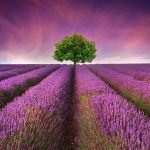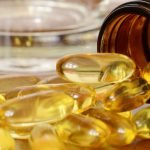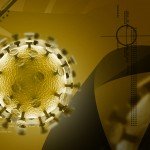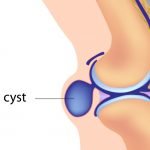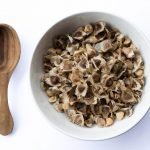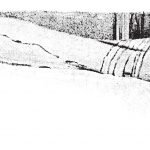Cold Water: Are You Ready to Try It?
Sussanna Czeranko, ND, BBE
Nature Cure Clinical Pearls
It was often said that Kneipp’s applications and his whole mode of treatment were too short to be beneficial. This at first seems true. ~ Alfred Baumgarten, 1903, pp.184-185
Cold water applications always produce heat and increase vitality, and the different douches [gushes] cause better metabolism, or assimilation of food; therefore, patients need more food, more rest and more exercise while taking them. ~Benedict Lust, 1904, p.148
When water is applied to a sick body in the right manner it will gradually act upon all diseased portions; it will search for the diseased matter, and dissolve and expel it so that one will gradually feel quite comfortable. ~ Rev T Hartmann, 1905, p.147
The temperatures of water used in hydrotherapy in the early years of naturopathy were often down-right freezing by today’s standards and experience. Sebastian Kneipp, known for his cold water gushes and douches, advocated for cold water but always for the shortest effective durations; in fact, sometimes they would be as brief as a few seconds.
Skin, the Depuration Organ
The skin itself was considered essential in employing cold-water therapies for the infirmed and sick. The functions of the skin are numerous, but what truly stands out is its role in excretion. Richard Metcalf notes: “As an excreting organ, the skin is of great importance, being said to perform nearly as much work as all the other depurating organs combined.” (Metcalf, 1901, p.121) Adding to Metcalf, Lust does not mince words when he says: “The skin is the most important of all the organs liberating the body from superfluous matter, and any method of cure which does not recognize and acknowledge this fact is not a healing method, but simply a pernicious proceeding, intended to shamefully defraud the people.” (Lust, 1909, p.238) Lust, a devoted adherent of Kneipp, employed cold water to strengthen and improve what he and early naturopathic doctors understood to be the essence of skin function.
The blood was the vehicle by which waste traveled, they explained to their patients, and the skin was the exit. When the blood was labeled as bad or poor, the plan of action was understood clearly by the early naturopaths. Alfred Baumgarten explained the solution: “The impurities must be driven out of the system, a new and healthy blood must be created.” (Baumgarten, 1903, p.124) He and the early naturopaths recognized the skin as a protective covering but also as the major emunctory organ, needing support in that function. Hydrotherapy was an ideal vehicle to accomplish the removal of morbid or unwanted matter from the body, in addition to improving the function of skin.
Dr Alfred Baumgarten was a physician who had worked side by side with Kneipp. He wrote extensively, expounding the scientific basis of cold water upon the skin. After Kneipp’s death, Baumgarten published a definitive tome at the time, Die Kneipp’sche Hydrotherapie, that recorded the experiments he conducted to validate Kneipp’s work. He writes, “Many ask themselves, how can it be possible that water only touching the skin, can affect the interior and can bring about such [marvelous] changes in the system.” (Baumgarten, 1903, p.124)
Cold Equals Contraction
We know that cold causes contraction and heat has the opposite effect of expansion. However, in order for cold to cause contraction of skin and blood vessels, there must be the presence of warm tissue. In other words, if the body is cold, there will be no contractive response. Thus, our forebears knew and taught that, in order to have a successful water treatment using cold water, one must be warm and not chilled. Lust writes: “The body must always be kept warm and exercise must be taken at once so as to promote and sustain quick reaction of the skin.” (Lust, 1905, p.147) The greater the temperature differential, the more significant the reaction of cold water on the body. Dr Bauergmund states this relationship as follows: “The warmer the body and the colder the water, the greater the effect.” (Bauergmund, 1908, p.70) He adds a caveat to the issue of cold: “There is a limit; if the water is too cold, no stimulation in the blood vessels, but lameness and relaxation would be the consequence; but such consequences will never happen if the water applied for treatment is never below 45° F / 7° C.” (Bauergmund, 1908, p.70)
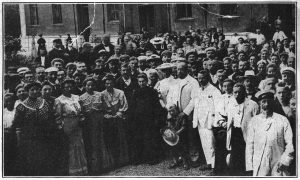
Baumgarten
When cold water touches the skin, the first observation is that the skin blanches because the blood vessels have contracted, causing blood to retreat to the interior. Baumgarten explains: “The skin turns a deathly pale, but if the flow of [cold] water continues, the skin will soon turn red again, for the one who applies the water knows that he must let water flow until the skin has regained this tint.” (Baumgarten, 1903, p.124) This color change from paleness back to a normal skin color was the reaction that indicated that the cold water had achieved its purpose and the treatment was done. Bauergmund also states the purpose for cold water: “The object of all cold water applications is to cause a stimulation in the circulation of the blood, and they must last only long enough for this reaction to take place.” (Bauergmund, 1908, p.71) This fundamental point in water applications could easily be missed or disregarded, but Baumgarten has provided us with one of the most important factors in successfully using water therapy: When administering cold-water therapies, we must be patient and wait for the patient’s body to react to the cold. This duration of time is not necessarily long and we must be diligent in our observation, so that we do not miss this change in color in our patients.
Pay Attention to the Reaction
Baumgarten noted that the time between the contraction of the capillaries that lie close to the skin and the expansion of those capillaries, resulting in the reddening reaction, is 70–80 seconds. After the color of the skin changes, the water application is terminated. For some patients, the color change is barely perceptible. Bauergmund, a colleague at that time, writes, “This [change in color] is not visible to the same degree in everybody, especially not in nervous people whose skin scarcely becomes red; it is enough for them if they only become warm.” (Bauergmund, 1908, p.71)
I want to add an important but perhaps not surprising sidebar related to this era: all of the references that I have found on cold water and its effects on skin are entirely from the Caucasian perspective. Unfortunately, and sadly, there are no references that I have found describing the observable effects of cold water on dark skin.
How the cold water is applied makes a difference. A cold water bath does not have the same effect as an 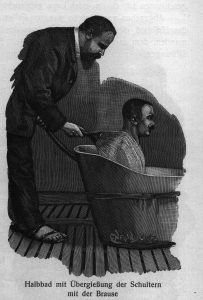 ablution (pouring on water) or a gush (streaming water). Kneipp’s signature water therapy was the gush, which he administered using a simple watering can or a hose. Gushes generated quicker reactions than bathing.
ablution (pouring on water) or a gush (streaming water). Kneipp’s signature water therapy was the gush, which he administered using a simple watering can or a hose. Gushes generated quicker reactions than bathing.
Practitioners are also well warned not to be too hasty. The paradox with regard to cold water is that one must apply the cold water quickly, but not so quickly that the patient’s body cools too suddenly. Bauergmund speaks on this subject: “Though all processes of the cold water treatment must be administered quickly, the cooling of the body should be done slowly.” (Bauergmund, 1908, p.71) The danger of cooling a patient too suddenly or too long often results in negative reactions, such as headaches and loss of appetite. Bauergmund adds, “The headache in the forehead, usually removed by walking, will altogether be avoided if the process is made by degrees.” (Bauergmund, 1908, p.71)
This last point is worth noting. When we introduce ourselves to cold-water treatments, we can begin by using small quantities of water, so that we do not shock ourselves and our patients into complete rejection. Lust provides a suggestion on how to remove the squeamishness from cold water: “A beginner should just take cold water out of a basin and apply it quickly to the arms, chest and upper part of the body, and then put on the clothing at once—without drying the skin with a towel.” (Lust, 1905, p.147)
Always Individualize
Those who followed Kneipp’s water healing methods stressed the importance of individualizing a patient’s treatment plan. On this point, Bauergmund states, “If by cold water the skin shall be induced to promote assimilation, rouse vitality in the body, and drive out the impurities, this stimulating process must be kept within certain lines, or more harm than good will be done, and the body will be weakened rather than strengthened.” (Bauergmund, 1908, p.73) Care must be taken, then, to not prescribe too many hydrotherapies and to prescribe based upon the constitution of the patient. Again Bauergmund cautions: “This rule is imperative: each individual has to be treated individually.” (Bauergmund, 1908, p.73)
This simple reddening reaction of the skin was used by Kneipp and his followers in their evaluation and determination of the prognosis for their patients and to guide their clinical treatment plan. Their interpretation might seem elementary to the perhaps more sophisticated and scientific intellect; however, we may do well to pay some attention to their wisdom, even if it doesn’t sizzle with science-speak. What Kneipp and others observed with astute perception was the movement and quality of blood. In their view, the quality of blood was paramount to health and, although their lexicon was not textured with scientific jargon, their clarity and consistency made it possible to widely appreciate and incorporate their ideas. In short, the skin’s design is such that it has the ability to discharge and remove from the body unwanted waste products and substances. Metcalf writes: “Excretion is an all-important depurating or purifying process; if the worn-out tissues of the body are not duly removed from the blood and discharged from the system, they rapidly accumulate and act as the deadliest poisons, the worst consequences to health and life often resulting.” (Metcalf, 1901, p.122)
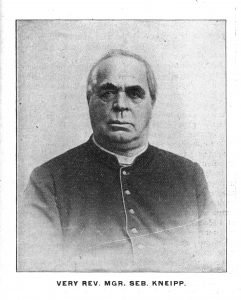
To the movement of blood, Baumgarten attributed an increase in oxygenation, which was, in his view, the key factor in neutralizing morbid or waste matter in the blood. Baumgarten continues: “The mass of blood rushing and flowing to and from the organs displaces and mingles with greater masses of blood. The larger the displacement and the oftener it occurs, the more improved the circulation in general will be.” (Baumgarten, 1903, p.126) Blood is constantly moving throughout the various organs in the body, uninterrupted in its metabolism and elimination of waste products. By using cold water applications, blood circulation is enhanced and so, too, are the benefits of increased discharge of waste products. Commenting on this important principle, Lorne Summers elaborates on the importance of cold water on the vitality of blood. He writes: “The more rapid the change of material in the body through the medium of the blood, that is, the more rapidly old material is carried away and new material deposited in its place, the higher the degree of vital activity, the more rapidly the wheels of life turn, the greater the amount of work done, [and] the more one really lives.” (Summers, 1920, p.287)
Kneipp was a renowned diagnostician and could accurately state the symptoms of a patient, frequently without questioning the patient. He would closely examine the patient’s skin to arrive at his diagnosis. Benedict Lust recounts: “Father Kneipp, the great water cure apostle, was always careful to examine the skin of his patients. If the “jacket,” as he termed it, seemed to be in good condition, he was always emphatic in predicting an early recovery. If the “jacket” was dry and shriveled, lacking in tone and contractile power, he would invariably shake his head and inform the patient that much time and treatment might be necessary before health was restored in him.” (Lust, 1929, p.254) Kneipp recognized the “importance of elimination and the importance of stimulating skin activity, no matter what the systemic disorder might be.” (Lust, 1929, p.254) Simplistic in design, but brilliant in execution, the application of water was then, and remains to this day, a powerful tool in the armamentarium of the naturopathic doctor.
References:
Abbott, G. K. (1914). Principles and Practice of Hydrotherapy. Loma Linda, California: The College Press.
Bauergmund, Dr. (1908). How should Kneipp’s treatment be taken? The Naturopath and Herald of Health, IX (3), 69–76.
Baumgarten, A. (1903). On the different effects of cold water. The Naturopath and Herald of Health, IV (5), 124–126.
Baumgarten, A. (1903). Water applications. The Naturopath and Herald of Health, IV (7), 184–185.
Hartmann, T. (1905). On the water-cure in general. The Naturopath and Herald of Health, VI (7), 147–149.
Lust, B. (1904). Father Kneipp and his methods. The Naturopath and Herald of Health, V (7), 145–149.
Lust, B. (1909). Culture of the skin as a curative. The Naturopath and Herald of Health, XIV (4), 238–240.
Lust, B. (1929). Ulcers, boils and skin diseases. Nature’s Path, XXXIV (6), 254–285.
Metcalf, R. (1901). Animal life is in a perpetual state of change. The Kneipp Water Cure Monthly, II (5), 121–127.
Summers, L. A. (1920). Nature’s cure for disease. Herald of Health and Naturopath, XXV (6), 286–288.
 Sussanna Czeranko ND, BBE, incorporates “nature-cure” approaches to primary care by including balneotherapy, breathing therapy, and nutrition into her naturopathic practice. Dr Czeranko is a faculty member working as the Rare Books curator at NCNM and is currently compiling a 12-volume series based upon Benedict Lust’s journals, published early in the last century. Her published books include: Origins of Naturopathic Medicine; Philosophy of Naturopathic Medicine; Dietetics of Naturopathic Medicine; Principles of Naturopathic Medicine; Vaccination and Naturopathic Medicine; and Physical Culture in Naturopathic Medicine. Dr Czeranko is the founder of the Breathing Academy, a training institute for naturopaths to incorporate a scientific model of breathing therapy called Buteyko into their practice. She is also a founding board member of the International Congress of Naturopathic Medicine and a member of the International Society of Medical Hydrology.
Sussanna Czeranko ND, BBE, incorporates “nature-cure” approaches to primary care by including balneotherapy, breathing therapy, and nutrition into her naturopathic practice. Dr Czeranko is a faculty member working as the Rare Books curator at NCNM and is currently compiling a 12-volume series based upon Benedict Lust’s journals, published early in the last century. Her published books include: Origins of Naturopathic Medicine; Philosophy of Naturopathic Medicine; Dietetics of Naturopathic Medicine; Principles of Naturopathic Medicine; Vaccination and Naturopathic Medicine; and Physical Culture in Naturopathic Medicine. Dr Czeranko is the founder of the Breathing Academy, a training institute for naturopaths to incorporate a scientific model of breathing therapy called Buteyko into their practice. She is also a founding board member of the International Congress of Naturopathic Medicine and a member of the International Society of Medical Hydrology.




